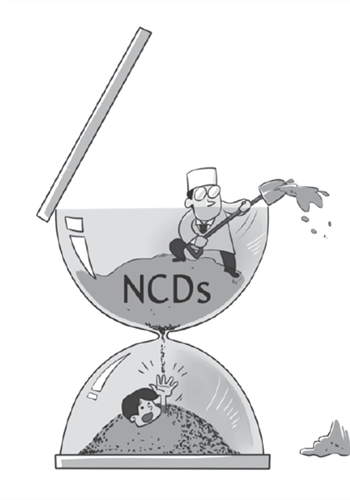
(Photo provided to China Daily)
Global health organizations and initiatives-in particular, the World Health Organization-have traditionally focused on infectious diseases, from malaria (their great failure) to smallpox (their greatest success). But there has long been a tiny corner of global health that has targeted chronic non-communicable diseases (NCDs) in low-and middle-income countries. As these countries make progress on development, pressure to expand that corner is mounting.
The WHO started paying attention to NCDs in the 1970s, when it launched its first programs to reduce cardiovascular disease. By 1977, the organization had a designated NCD division. In 1985, the World Health Assembly adopted resolution WHA 38.30, calling for member countries to elaborate new strategies for addressing their NCD problems.
Two programs were initiated: one serving Western Europe and another, called Inter-Health, which focused on a mix of countries, from Chile and Tanzania to Finland and the United States. The goal of Inter-Health was to coordinate a set of experimental local projects, in order to develop a flexible program template applicable to countries at different stages of development.
It was a step in the right direction. But, for years, it was pretty much the only step the WHO took on NCDs in low -and middle-income countries. Then, in 1993, the World Development Report, and the subsequent Global Burden of Disease Study, quantified the extent of the NCD problem in low-income countries. It was a breakthrough for NCD activism.
The WHO responded to that breakthrough -- and the criticism it triggered-with major reforms. By leading a growing advocacy coalition (in which the journal The Lancet played a central role), the WHO established itself as a leader in the fight against NCDs. The high point was the special United Nations meeting in 2011 devoted to NCDs.
But all these efforts have produced only mixed results, because NCD funding has only just kept up with overall global health funding -- just 1-3 percent (depending on who is counting) of total development health assistance. As such, most governments in low-income regions appear to have done relatively little to address NCDs.
However, NCDs in low-and middle-income countries have lately been getting more attention. The 2013 Global Burden of Disease Report identified NCDs as the dominant health problem everywhere except Sub-Saharan Africa. More recently, a report by the Council on Foreign Relations indicated that mortality from NCDs for people under 60 is more than three times higher in low-income countries than in high-income countries.
Such reports highlight the threat posed by NCDs in low-and middle-income countries. For one thing, more countries are achieving middle-income status, bringing both lifestyle changes that affect the composition of disease burdens and creating a powerful constituency for better health services.
While there is a broad consensus on the need to pay more attention-and deliver more resources-to fighting NCDs, the consensus breaks down when it comes to how to carry out the fight. But everyone agrees on one critical point: adequate funding is needed.
Donors with far more money than the WHO-agencies of the American and European governments, private philanthropies and NGOs-are pursuing the same approach, investing overwhelmingly in efforts to control communicable diseases. Low-and middle-income countries have done the same.
Infectious diseases-immediate and capable of spreading widely thanks to modern transportation-are compelling targets. NCDs-lowly evolving chronic conditions that primarily affect older adults and are unlikely to be resolved with a quick technological fix-are not. The fact that an effective program for tackling NCDs could involve lengthy confrontations with powerful multinational interests (like the food industry) does not help, either.
Nonetheless, the tide may be turning. Advocacy continues to gain traction. A new East African NCD Alliance-a loose coalition of civil society organizations-has been created to tackle the challenge in that region. Other groups have also emerged. And, as NCDs command more attention, resources will most likely begin to follow, however slowly.
Of course, at that point, intense disagreements about how to use those resources will surely arise. Prevention will be critical, though, after 60 years of confronting NCDs in advanced countries, it is clear that acute interventions tend to attract more support. In any case, one hopes that something has been learned from our decades of experience in fighting NCDs, and that these lessons can be applied in the more challenging and resource-poor settings of the developing world.
By George Weisz
The author is a professor of the History of Medicine at McGill University, Canada Project Syndicate.


















































